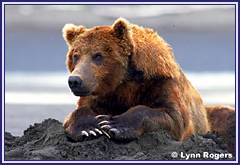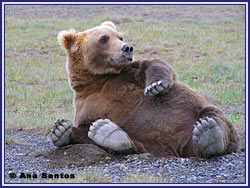
Brown bear watching & wildlife tours on the coast of Katmai National
Park, Alaska
Ursus arctos, Brown Bear, Grizzly Bear
Physical Characteristics
 The largest of
living carnivores, grizzly bears are 5 - 8 feet in length from head to
rump. They are 3½ - 5 feet tall at the shoulder and can tower at an
intimidating height of 8 - 10 feet when standing upright on their hind legs.
On average, adult males are larger than females. Ursus arctos
is largest along the coast of southern Alaska and on nearby islands where
mature males can weigh as much as 1,400 pounds and mature females 700
pounds. Size rapidly declines to the north and east. Fur is usually dark
brown, but varies from light blond to almost black. Individuals in the Rocky
Mountains have long hairs along the shoulders and back, which are frosted
with white, thus giving a grizzled appearance and hence the common name
"grizzly bear". Ursus arctos has an excellent sense of smell (able to
follow the scent of a rotting carcass for miles), human-level hearing and
eyesight. Brown bears are extremely intelligent, resourceful and
opportunistic, allowing the grizzly to live in a variety of habitats. The largest of
living carnivores, grizzly bears are 5 - 8 feet in length from head to
rump. They are 3½ - 5 feet tall at the shoulder and can tower at an
intimidating height of 8 - 10 feet when standing upright on their hind legs.
On average, adult males are larger than females. Ursus arctos
is largest along the coast of southern Alaska and on nearby islands where
mature males can weigh as much as 1,400 pounds and mature females 700
pounds. Size rapidly declines to the north and east. Fur is usually dark
brown, but varies from light blond to almost black. Individuals in the Rocky
Mountains have long hairs along the shoulders and back, which are frosted
with white, thus giving a grizzled appearance and hence the common name
"grizzly bear". Ursus arctos has an excellent sense of smell (able to
follow the scent of a rotting carcass for miles), human-level hearing and
eyesight. Brown bears are extremely intelligent, resourceful and
opportunistic, allowing the grizzly to live in a variety of habitats.
Adult males of the coast of Katmai National Park and the Alaska
Peninsula are among the biggest brown bears on the planet, even as large as
the famous Kodiak brown bears, considered to be the largest in the world.
Food Habits
The diet of Ursus arctos consists mainly of vegetation, and
shifts to different foods as the seasons progress. In spring, grasses,
sedges, roots, moss and bulbs are mainly eaten. During summer and early
autumn, berries are essential, with bulbs and tubers also eaten. Ursus
arctos consumes insects, fungi and roots at all times of the year and
also digs mice, ground squirrels and marmots out of their burrows. Grizzly
bears are also carnivorous, feeding on moose, caribou, mountain sheep and
goats. In Alaska, along the coast, brown bears feed on the vulnerable
populations of salmon in the summer, as well as other marine mammals which
wash ashore or get trapped in tidal areas.
Reproduction
 Mating of brown bears takes
place from May to July, although the fertilized eggs are not implanted in
the uterus until hibernation. Births occur during January and February,
while the female is in hibernation. Females remain in estrus throughout the
breeding season until mating occurs, and do not ovulate again for at least 2
(usually 3 or 4) years after giving birth. Generally, two offspring, which
are blind at birth, are born per litter and remain with their mother until
their third summer of their life (usually until the fourth, at 3 1/2 years
old) unless premature death occurs, commonly caused by other bears, leading
to the belief that males may intentionally kill young cubs so females return
to estrus, although this is currently a controversial issue and there is no
scientific data supporting this belief. Brown bears mature sexually between
5 - 7 years of age - females first, then males - but continue growing until
they are 10 - 11 years old. Bears have been known to live and reproduce at
25 years of age, with a potential life span of up to 35 years. Mating of brown bears takes
place from May to July, although the fertilized eggs are not implanted in
the uterus until hibernation. Births occur during January and February,
while the female is in hibernation. Females remain in estrus throughout the
breeding season until mating occurs, and do not ovulate again for at least 2
(usually 3 or 4) years after giving birth. Generally, two offspring, which
are blind at birth, are born per litter and remain with their mother until
their third summer of their life (usually until the fourth, at 3 1/2 years
old) unless premature death occurs, commonly caused by other bears, leading
to the belief that males may intentionally kill young cubs so females return
to estrus, although this is currently a controversial issue and there is no
scientific data supporting this belief. Brown bears mature sexually between
5 - 7 years of age - females first, then males - but continue growing until
they are 10 - 11 years old. Bears have been known to live and reproduce at
25 years of age, with a potential life span of up to 35 years.
Behavior
Ursus arctos may be active at any time of the day, but
generally forages in the morning and evening, and rests in dense cover by
day. Brown bears may excavate shallow depressions in which to lay, commonly
referred to as day beds. Seasonal movements of Ursus arctos have been
observed, with individuals sometimes traveling many miles during the autumn
to reach areas of favorable food supplies, such as salmon streams, and areas
of high berry production. Home ranges can be as large as 800 square miles,
but are on average between 50 and 150 square miles, with male ranges being
greater than female ranges. Home ranges overlap extensively, and there is no
evidence of territorial defense, although bears are generally solitary.
Occasionally, bears gather in large numbers at major food sources and form
family foraging groups with more than one age class of young. Under these
conditions, dominance hierarchies are usually formed and maintained with
aggression. Highest-ranking individuals are large adult males, although the
most aggressive bears are females with young. Least aggressive and
lowest-ranking are adolescents. The only social bonds formed are between
females and young. During the breeding season, males may fight over females
and guard their mates for 1 - 3 weeks. On the coast of Alaska, where bears
gather in large concentrations, females often mate with several males,
resulting in cubs being born by different fathers.
Ursus arctos begins hibernation in November - December, and
resumes activity in March - April, with the exact period dependent on the
location, weather, and condition of the individual. In certain southern
coastal locales, hibernation is very brief or may not occur at all. Most
often, brown bears dig their own dens and make a bed out of dry vegetation.
Burrows are usually located on a sheltered slope, either under a large stone
or among the roots of a mature tree. In certain areas on the Alaska
Peninsula lava caves formed by past volcanic eruptions are used. Dens are
sometimes used repeatedly year after year.
 Ursus arctos moves
with a slow, lumbering, ungainly gait as both feet on a side move forward
together. Bears are also plantigrade – like humans, but unlike most other
animals, they walk flat-footed on both the soles and the toes of their feet.
Awkward appearing or not, brown bears are able to run over 30 mph for a
short distance. They are mainly terrestrial, although they can often be
found swimming or preying upon fish in the water along coastal areas. It is
very unusual for adults to climb trees. Ursus arctos moves
with a slow, lumbering, ungainly gait as both feet on a side move forward
together. Bears are also plantigrade – like humans, but unlike most other
animals, they walk flat-footed on both the soles and the toes of their feet.
Awkward appearing or not, brown bears are able to run over 30 mph for a
short distance. They are mainly terrestrial, although they can often be
found swimming or preying upon fish in the water along coastal areas. It is
very unusual for adults to climb trees.
Habitat
Brown bears occupy a variety of habitats, but in the New World they
seem to prefer open areas such as tundra, alpine meadows and coastlines.
Historically, they were common on the Great Plains prior to the arrival of
European settlers. In Siberia, they are found primarily in forests, while
European populations are restricted mainly to mountain woodlands. The main
habitat requirement for Ursus arctos is an area with dense cover in
which it can have shelter by day.
The brown bear has been long considered the most dangerous animal
in North America, although real danger of attack is often exaggerated. In
general, brown bears attempt to avoid human contact and will not attack
unless startled at close quarters with young or engrossed in a search for
food. However, they are very unpredictable in temperament, and often exhibit
impulsive and petulant behavior.
On the coast of Katmai National
Park, where bears are not hunted or harassed, the bears are tolerant
and curious about the rare human visitors, but mostly, they completely
ignore our presence.
Some populations are clearly endangered, others are not. Grizzly
bear numbers have dropped dramatically since the turn of the century, when
settlers and livestock flooded the western U.S., driving the grizzly out of
much of its former range. Grizzlies now cling to a mere 2 per cent or less
of their former range. Logging, mining, road construction, resorts,
subdivisions, golf courses, etc., have all encroached on suitable bear
habitat, resulting in a decrease in bear numbers. Grizzly bear numbers were
estimated at 100,000 in the conterminous United States in the early 1900's,
but there are now fewer than 1,000. In the greater Yellowstone area, there
were 250 bears in 1972; the grizzly was then included in the endangered
species list. Today, population estimates account for 600 individuals and
the grizzly may soon be removed from the list, which might result in the
species being hunted once again. Brown bears are still fairly common in the
mountainous regions of western Canada and Alaska, perhaps numbering about
30,000 individuals. In Eurasia, there are an estimated 100,000 bears, with
about 70,000 of those living in the former Soviet Union.
For more information on Alaska's bears, visit
http://www.wildlife.alaska.gov/index.cfm?adfg=bears.main
[ The Last Best Place ] [ The "Waters", the Bears, the Idea ] [ Ursus arctos, Brown Bear, Grizzly Bear ] [ Services for Film Makers ]
[ Home ]
[ Site Map ] [ Tour Details ]
[ Booking Info ]
[ Photos ]
Site created & maintained by Net Alaska Web Services Homer, Alaska
© Katmai coastal Tours and Net Alaska Web Services, Homer, AK
|



